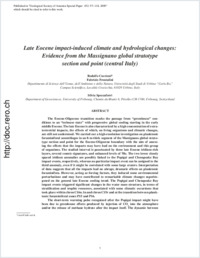Late Eocene impact-induced climate and hydrological changes: Evidence from the Massignano global stratotype section and point (central Italy)
- Coccioni, Rodolfo Dipartimento di Scienze dell'Uomo, dell'Ambiente e della Natura, Università degli Studi di Urbino “Carlo Bo,” Urbino, Italy
- Frontalini, Fabrizio Dipartimento di Scienze dell'Uomo, dell'Ambiente e della Natura, Università degli Studi di Urbino “Carlo Bo,” Urbino, Italy
- Spezzaferri, Silvia Department of Geosciences, University of Fribourg, Switzerland
-
2009
Published in:
- Geological Society of America Special Paper. - 2009, vol. 452, p. 97–118
planktonic foraminifera
impacts
hydrological changes
climate changes
late Eocene
Massignano
central Italy
English
The Eocene-Oligocene transition marks the passage from “greenhouse” conditions to an “icehouse state” with progressive global cooling starting in the early middle Eocene. The late Eocene is also characterized by a high concentration of extraterrestrial impacts, the effects of which, on living organisms and climatic changes, are still not understood. We carried out a high-resolution investigation on planktonic foraminiferal assemblages in an 8-m-thick segment of the Massignano global stratotype section and point for the Eocene-Oligocene boundary with the aim of assessing the effects that the impacts may have had on the environment and this group of organisms. The studied interval is punctuated by three late Eocene iridium- rich layers, several cosmic signatures, and enhanced levels of ³He. The two lower closely spaced iridium anomalies are possibly linked to the Popigai and Chesapeake Bay impact events, respectively, whereas no particular impact event can be assigned to the third anomaly, even if it might be correlated with some large craters. Interpretation of data suggests that all the impacts had no abrupt, dramatic effects on planktonic foraminifera. However, acting as forcing factors, they induced some environmental perturbations and may have contributed to remarkable climate changes superimposed on the general late Eocene cooling trend. The Popigai and Chesapeake Bay impact events triggered significant changes in the water mass structure, in terms of stratification and trophic resources, associated with some climatic excursions that took place within chron C16n.1n and chron C15r and at the transition between planktonic foraminiferal zones P15 and P16.The short-term warming pulse recognized after the Popigai impact might have been due to greenhouse effects produced by injection of CO₂ into the atmosphere and/or the release of methane hydrate after the impact itself. The dynamic between hydrological and climate changes across the impactoclastic layers as observed at Massignano displays different features at each impact event, probably due to the context in which each occurred in terms of impactor size, location, and target rocks. The relatively long duration of the enhanced cooling following the Chesapeake Bay impact suggests that this event induced a progressive cooling and triggered a feedback mechanism that sustained the initial impact-induced changes. Similar patterns of climatic excursions reported worldwide across the equivalent impact-ejecta horizons indicate that the impact-induced climate changes recorded at Massignano appear to be global in extent.
- Faculty
- Faculté des sciences et de médecine
- Department
- Département de Géosciences
- Language
-
- English
- Classification
- Palaeontology
- License
- License undefined
- Identifiers
-
- RERO DOC 11994
- DOI 10.1130/2009.2452(07)
- Persistent URL
- https://folia.unifr.ch/unifr/documents/301158
Statistics
Document views: 80
File downloads:
- spezzaferri_lei.pdf: 305
